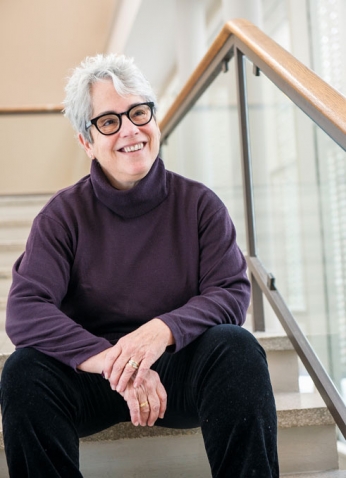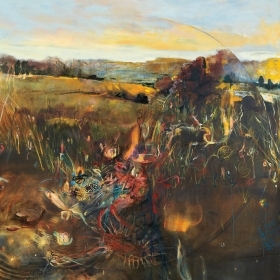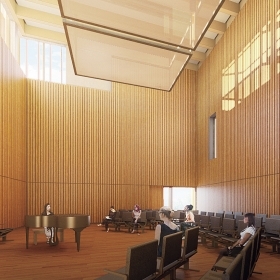Photo by Richard Howard
When Alice Friedman, the Grace Slack McNeil Professor of Art, lectures her architecture classes about the Jewett Arts Center, Paul Rudolph’s breakthrough building that was completed in 1958—and also the building in which her classes are taught—she likes to take them down the hall to its Sculpture Court. When Jewett opened, this dynamic, multilevel area served as a gathering place for members of the Wellesley community, and as a permanent exhibit space, featuring a 5th-century Roman mosaic as a focal point.
The Sculpture Court has changed quite a bit since 1958. Many of the permanent works of art, including the mosaic, are now on display in the Davis Museum, which opened in 1993. The space now hosts a series of temporary exhibits. Also, parts of its dramatic floating staircase originally only had railings on one side—Rudolph was a fan of “architectural excitement through danger,” says Friedman. Building codes, however, are not very tolerant of danger, and more rails were added later, along with glass infill. Even with the changes, Friedman adores the space. “I love the section—the vertical distribution of spaces and floors,” she says. “It’s really interesting the way it drops off in places, and the way the stairs rise up through the sculpture court to the top. Even with the glass in [the rails], it’s just really beautiful.”
Modern architecture is very close to Friedman’s heart—she’s written two books on the subject, American Glamour and the Evolution of Modern Architecture and Women and the Making of the Modern House. Over the past several years, though, she has focused her attention on Jewett. As the renovation of and addition to Pendleton West were underway, the art and music departments were constantly coming up against the question of how much renovation could be done in Jewett, given the challenge of balancing its daring and unusual spaces with building codes. Luckily, Friedman learned about the “Keeping it Modern” grants for architectural preservation through the Getty Foundation. In 2015, the College secured a large grant to support the development of a conservation management plan for Jewett.
‘Now [Jewett’s] much loved. [Scholars] come and work on it, write about it. Students of architecture, too, from Harvard and MIT and around the world. There are always student groups sketching it.’
—Professor of Art Alice Friedman
The plan, which was completed early this year, “looks at the building from top to bottom in terms of what’s needed to keep the building functioning, but also which spaces have been altered beyond repair, and which spaces need to be returned to their original condition or could be,” Friedman says. Friedman directed the project, working with Martha McNamara, director of the New England Arts and Architecture Program at Wellesley; Martin Brody, the Catherine Mills Davis Professor of Music; Timothy Rohan, a professor at the University of Massachusetts Amherst and the author of The Architecture of Paul Rudolph; architectural consultants David Fixler and Priya Jain from EYP in Boston; and Jon Alvarez, director of design and construction at Wellesley.
Jewett was unique at the time in that Paul Rudolph “tried very hard to make a modern building that was contextual within a historical campus,” Friedman says. You see it in the pyramidal skylights that echo the pinnacles of the Galen Stone Tower, for example, and in his use of brick. “We found some beautiful drawings where he had looked at Green and Founders, and at the dimensions of the windows and the dimensions of the gables, and incorporated those dimensions into Jewett,” she says. Friedman says that after years of being considered outside the Modernist canon, Jewett is being newly appreciated even beyond Wellesley: “Now it’s much loved. [Scholars] come and work on it, write about it. Students of architecture, too, from Harvard and MIT and around the world. There are always student groups sketching it.”
While it has yet to be determined when the renovation will take place—funding needs to be found—Friedman hopes it will be in keeping with Jewett’s original mission to keep the arts together. “We’re thinking about how we could take that legacy of arts interdisciplinarity and continue it. What kinds of spaces could we use for new media that would include visual, sound, installation, and performance art together with traditional media?”







We ask that those who engage in Wellesley magazine's online community act with honesty, integrity, and respect. (Remember the honor code, alums?) We reserve the right to remove comments by impersonators or comments that are not civil and relevant to the subject at hand. By posting here, you are permitting Wellesley magazine to edit and republish your comment in all media. Please remember that all posts are public.